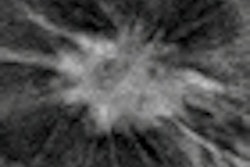Among patients with abnormal mammograms, one-view digital breast tomosynthesis (DBT) showed better sensitivity and negative predictive value than full-field digital mammography (FFDM) for those with fatty and dense breasts, according to a study published in the January issue of the American Journal of Roentgenology.
Dr. Christian Waldherr, from the Breast Center Bern in Switzerland, and colleagues compared the diagnostic value of one-view DBT to two-view FFDM alone, as well as to a combined reading of both modalities (AJR, January 2013, Vol. 200:1, pp. 226-231). Their goal was to see if DBT has a role in daily clinical practice in terms of working up women with suspicious mammograms.
"In recent studies, two-view digital breast tomosynthesis was shown to be subjectively better than two-view FFDM at highlighting masses and areas of architectural distortion with only minimal added radiation," the authors wrote. "Conventional mammography, in contrast, is reported to be better at delineating the morphology of calcifications. Still, digital breast tomosynthesis is thought to have the potential to lower the recall rate if used in combination with two-view FFDM."
While most recent studies on tomosynthesis have employed a two-view technique, Waldherr and colleagues decided to test the performance of a one-view protocol. One-view tomosynthesis has been explored as a way to generate 2D mammograms from 3D tomosynthesis datasets, avoiding the need for screening patients to undergo both tomosynthesis and conventional digital mammograms.
In the group's one-view tomosynthesis protocol, 11 projection images were acquired of the mediolateral (MLO) view in increments of 1.4° and an imaging time of four seconds on a DBT system (Selenia Dimensions, Hologic). The 11 projection images were reconstructed into a series of planar images at 1-mm intervals; radiation dose was equivalent to that of a single-view FFDM image.
The study included datasets of one-view DBT and two-view FFDM of abnormal mammograms in 144 consecutive women admitted for diagnostic workup with clinical signs and symptoms (78 patients) or recalled from screening (66 patients). The women were imaged between December 2008 and June 2009, and the nature of the lesions was confirmed by histologic analysis of biopsied tissue or by 12- to 16-month follow-up appointments.
Eighty-six of the 144 patients were determined to have breast cancer, according to the authors. The BI-RADS categories for one-view DBT were significantly better than for two-view FFDM, and they were equal to those of combined reading in the women admitted for diagnostic workup and those recalled from screening.
The sensitivity and negative predictive values (NPV) of DBT (84% and 76.5%, respectively) were superior to those of FFDM (70.5% and 61.8%) in fatty and dense breasts overall. They were also superior in women admitted with clinical signs and symptoms (88.7% DBT sensitivity vs. 75.8% FFDM; 68.2% DBT NPV vs. 43% FFDM) and in women recalled from screening (87.5% DBT sensitivity vs. 70.8% FFDM; 90.9% DBT NPV vs. 81.1% FFDM).
FFDM, DBT, and combined reading in all 144 patients
|
Digital breast tomosynthesis also reduced callbacks, Waldherr's team found: Only 11% of DBT exams required additional imaging, compared with 23% of FFDM exams.
"The advantages of one-view digital breast tomosynthesis, such as its significant superior predictive values (sensitivity and NPV) and its significant reduction of the need for additional imaging in breasts of both low and high density, strongly support its routine use at least in patients with an abnormal mammography," the authors concluded.




















